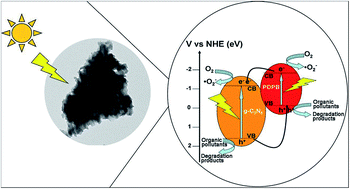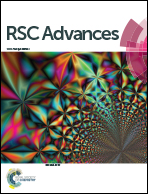A binary polymer composite of graphitic carbon nitride and poly(diphenylbutadiyne) with enhanced visible light photocatalytic activity
Abstract
New polymer composites consisting of poly(diphenylbutadiyne) (PDPB) and g-C3N4 have been successfully prepared. UV-vis diffuse reflectance spectra show that the existence of PDPB in composites can clearly increase the visible light absorption of the catalysts. Photoluminescence spectroscopy and photoelectrochemical measurements reveal that PDPB can effectively facilitate the charge carrier separation in the composites. Compared with pure g-C3N4 or pure PDPB, the composite catalysts exhibit observably enhanced visible-light photocatalytic activity for degradation of RhB and phenol. A possible mechanism for the charge separation and transfer in the composite catalysts is proposed. In addition, the composite catalysts show stable catalytic performance after five successive runs, displaying potential for applications in various fields of photocatalysis.



 Please wait while we load your content...
Please wait while we load your content...